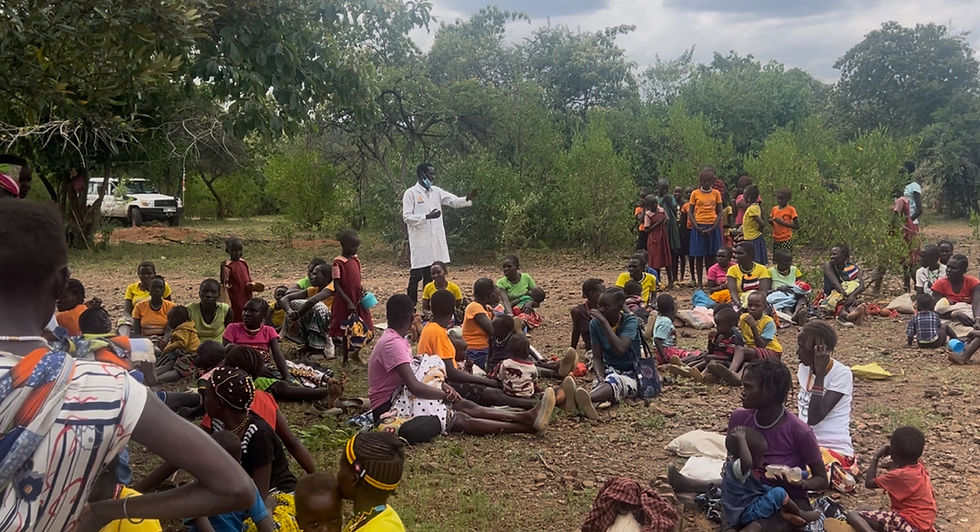Using Qualitative Research Methods to Destigmatize Women's Health Issues: Insights on Obstetric Fistula and Visceral Leishmaniasis
- Abigail Williams
- Jan 6
- 4 min read
Focus group discussions (FGDs) are invaluable tools in qualitative research, providing rich insights into people's perceptions, beliefs, attitudes, and experiences. Unlike individual interviews, FGDs bring together small groups to discuss specific topics, encouraging participants to express themselves openly and interact with one another. They are particularly valuable in exploring stigmatized topics like obstetric fistula and female genital cutting (FGC), as they create a supportive environment where participants can discuss sensitive issues more openly than in individual interviews. In FGDs, participants may feel more comfortable discussing complex or taboo topics by hearing others' experiences first, which can lead to richer insights than one-on-one settings. This was seen explicitly in our FDG held at the TERMES Center conference hall on September 17, 2024.
Originally planned to begin at 7:00 a.m., the session started closer to 12:30 p.m.—a common occurrence when working with pastoral communities, where the concept of time is more flexible. A local pastor opened the focus group discussion with a prayer, setting a respectful tone for the gathering. In attendance were nine women and two children, five of whom were fistula survivors who had undergone repair surgery in April 2024. Of these five, only three had successfully recovered. Despite the heavy subject matter, there was an overwhelming sense of confidence and community throughout the room. Although early on in the FDG the older women spoke out, as the conversation evolved the feedback from each participant equaled out. The encouragement from those around them who shared this experience heightened their own comfort in sharing their stories.
The main objective of the FDG was to explore women’s experiences of living with multiple disease burdens, primarily centered on visceral leishmaniasis and obstetric fistula. By focusing on women who have faced maternal health challenges, like fistula, the session provided invaluable insights into how these health issues affect their daily lives as mothers and community members. The discussion aimed to deepen our understanding of the ongoing impact that such health burdens have on their personal and social lives. The greatest limitation to this FDG was the language barrier between Pokot and English. To combat this, a translator and community nurse was hired to disseminate the questionnaire. A second translator worked to provide real time translation which allowed me to include follow-up questions. Then, after the entire session had been recorded, it was translated onto paper for further analysis. The results can be summarized in the following:
Experiences with Visceral leishmaniasis:
Community members have heard of Kala-azar and recognize some of its symptoms, like swelling of the stomach, fatigue, and excessive sweating, which they differentiate from malaria after initial symptoms don’t respond to malaria treatment. Many associate the disease with a “small insect also known” as Kalalian in pokot” from an anthill”-Tulwo in Pokot and sometimes with witchcraft, especially if symptoms worsen or if there’s a family or neighbor dispute. Traditional herbal remedies are often tried before turning to formal healthcare, as there’s limited understanding of Kala-azar and its severity. Misdiagnosis is common, as it’s often mistaken for malaria or other conditions, and local dispensaries may lack the resources or knowledge for proper diagnosis. Even when a diagnosis is made, families may delay or avoid seeking treatment due to costs, lack of education, and reliance on traditional beliefs. In some cases, family conflicts or issues like alcoholism prevent timely care, while economic challenges and the need to manage livestock further limit access to treatment. However, increased awareness from healthcare facilities like Chemolingot sub-county hospital, which now treats Kala-azar, has led some community members to recognize the symptoms and seek hospital care, particularly when they have seen relatives or neighbors successfully treated.
Experiences with obstetric fistula:
Initially unaware of fistula, most women learned about the condition only after experiencing it themselves. Symptoms like urine leakage, itching, and swelling prompted them to seek medical help, often with support from pastors or family members. Many were treated with a catheter or surgery, although not all surgeries were successful, with some women needing multiple attempts and still facing persistent leakage. Fistula is understood to result from prolonged or obstructed labor, early pregnancy, and female genital mutilation (FGM), with awareness of increased risks from intercourse and early marriages. While treatment was provided free of charge, stigma and isolation were prevalent; some women faced rejection from their husbands, while others received support but were encouraged to stay away from family until treated. Waiting periods for surgery due to low weight or other factors left some women further isolated and stigmatized. Despite treatment, concerns about infertility remain common, with some women experiencing lasting social rejection or divorce due to the condition. Fear of stigma prevents some women from disclosing or seeking treatment, making fistula a deeply isolating experience for many.
Education and sensitization are the most important tools in quieting the social stigma against these women. By continuing to coordinate with prominent figures in the community such as village chiefs, traditional healers, traditional birth attendants, and pastors, we can close the gap in knowledge of these diseases. Further expanding mobile clinics and outreach programs will also allow for this information to reach even the most remote locations of Pokot residence.






Comments